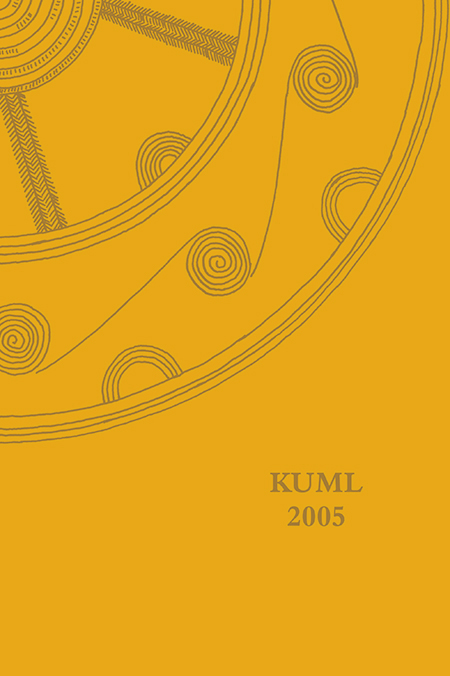En senneolitisk stenkiste i Bjergby på Mors
DOI:
https://doi.org/10.7146/kuml.v54i54.97311Nøgleord:
senneolitisk stenkiste, MorsResumé
A Neolithic Stone Coffin in Bjergby on Mors
The mound is located on “Højsager” in Bjergby on the peninsula Mors. P.C.O. Nørgard from Morsland’s Historical Museum investigated it in 1966. The excavation exposed a small stone coffin in the eastern side of the mound. It contained a well-preserved skeleton of a slight person. A double button from Period II found at the waist, dates the grave to the Early Bronze Age. At the foot of the grave was also a heap of burnt human bones. They may be the remains of a person sacrificed – a parallel to the bundle of burnt bones found in the grave of the Egtved girl.
In the centre of the mound was another coffin, which had been disturbed. The grave fill was completely messed up, but it did contain some skeleton remains.
A third stone coffin was found south of the mound centre, just underneath the ploughed soil. It had been built in a deep hole, filled with stones. Above and around the grave and just underneath the layer of ploughed soil was a 35-40-cm thick, tightly packed stone layer. This stone layer covered several layers of flat stones covering the grave. Apart from a single granite stone, they were all sedimentary rock from the moler clay layer, at least one came from the beach about 3.5 km away. The large flat stones were packed closely so that they constituted a four-layer cover. The stone coffin was almost precisely E-W orientated. It was 1.9-m long and 0.40-m wide and built from thin plates of sedimentary rock. Each long side was made from four carefully fitted side stones, with a single stone at either end. In the eastern end, a clay border adjoined the side stones. The floor in the coffin was made from thin, flat plates of sedimentary rock, joined with sand.
On the bottom of the coffin was a very well preserved skeleton, stretched out on the back with the head towards the west. By the left arm of the skeleton was a c.26- cm long flint dagger of type IC, with parallel chipping. The end of the handle had been used to strike light.
The proportions and other design of this late Neolithic stone coffin correspond completely to the stone coffins from the Early Bronze Age. The type classification should therefore be considered defi nite. The coffin contained just one body, completely undisturbed. Next to the body was a type IC knife. The structure thus undoubtedly dates from the SN A and represents a stone coffin positively dating from this period.
Stone coffins differ from stone cists in that the latter are burial chambers constructed for the repeated burial of a wood coffin or a wrapped body, whereas stone coffins are individual grave structures meant to be used only once for a wood coffin or a wrapped body. The stone coffins are a very frequent grave type during the Early Bronze Age, and at least two Zealandic stone coffins date already from period I of the Bronze Age.
So far, the question has been whether there are also Late Neolithic stone coffins, i.e. grave structures consisting of flat stone blocks built during the Late Neolithic for just one body, which was placed in the stone grave during the funeral for which it was built. The dating of this stone cist to the SN A shows that this was the case.
At the same time it makes it probable that a number of other stone coffins should also date from the Late Neolithic, for instance grave A in the burial mound of ”Solbakken” in Skodsborg on Zealand. This grave contained a single skeleton, stretched out on its back with the head towards the west and with a knife in the belt. The knife belongs to type IIB and dates the grave to SN B. The stone coffin was contemporary with the stone cist (grave B), which was also found in the mound. This structure thus documents that stone coffins and stone cists could be built at the same time during the late Neolithic.
Two stone coffins were found in the easternmost of the Tågerup mounds by Hejnstrupgård in eastern Zealand. Both seem to have been built for just one burial, and at least stone coffin A is positively identified as a Late Neolithic stone coffin.
An older find from Skræm in Thy probably represents a Late Neolithic stone coffin. A flint dagger of type VC gives it a dating from SN C. Several other finds, two of which were made at Grurup and Vestervig in Thy respectively, are more uncertain.
The investigation shows that stone coffins were built during the whole of the Late Neolithic simultaneously with stone cists. Apart from the stone coffins from “Solbakken” in Solrød and the “Eastern Tågerup mound” by Hein strupgård, are all structures situated in the western Limfjord area. We are thus dealing with a predominantly local grave form. The continuity with the stone coffins of the older Bronze Age is very clear, not only concerning the construction by Heinstrupgård, but also in the Limfjord area, as the stone coffins from period II are clearly concentrated within the Thy area.
Klaus Ebbesen
Hørsholm
Translated by Annette Lerche Trolle
Downloads
Publiceret
Citation/Eksport
Nummer
Sektion
Licens
Fra og med årgang 2022 er artikler udgivet i Kuml med en licens fra Creative Commons (CC BY-NC-SA 4.0).
Alle tidligere årgange af tidsskriftet er ikke udgivet med en licens fra Creative Commons.


